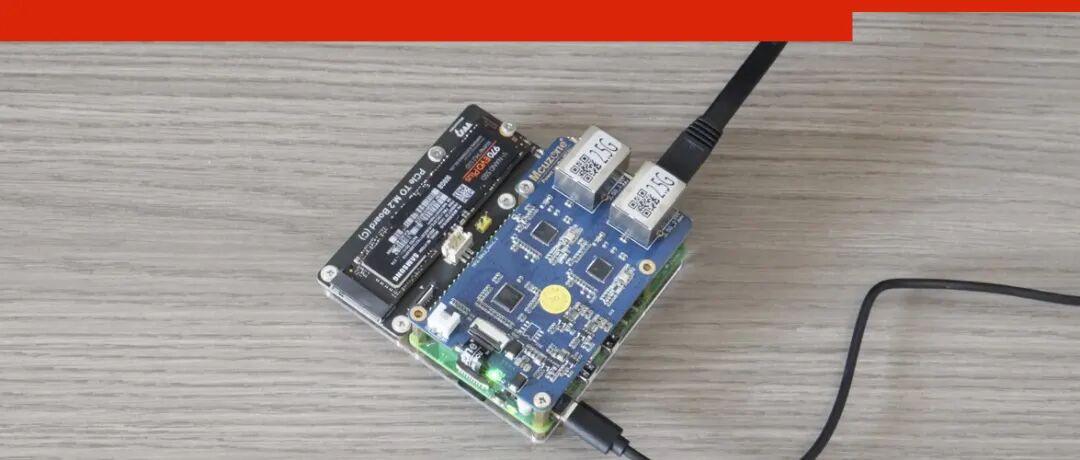
Author: DigiKey Editor
Keywords: Development Board, Open Source Hardware, Evaluation

Abstract
This article is a comparative evaluation of the Raspberry Pi 5 and its predecessors. It details the key hardware specifications of four Raspberry Pi models and compares their performance in CPU, memory, network, NGINX server performance, and TF card read/write speeds through practical testing, providing valuable reference information for makers and developers interested in Raspberry Pi.
The Raspberry Pi, as the “leader” in open-source hardware, is beloved by makers, especially in the realms of smart home, NAS, and smart hardware, holding a significant market share.
The latest Raspberry Pi 5 has received mixed reviews. How does its performance really stack up? In this video, we will not discuss parameters but will conduct practical tests to see how the Raspberry Pi 5 compares to its siblings.
The contenders are currently the star products of Raspberry Pi SBCs. Can you match their names?
From left to right are the Zero 2W, PI3B+, PI4, and the latest PI5. Did you guess correctly? Those who recognized them at a glance are definitely loyal fans of Raspberry Pi. These models are the ones I currently use and are among the most popular.
Before the evaluation, let’s list the key hardware specifications of these boards for those who may not be familiar with them.
Is the Raspberry Pi 5 a true performance breakthrough or just a minor upgrade? Let’s wait and see.
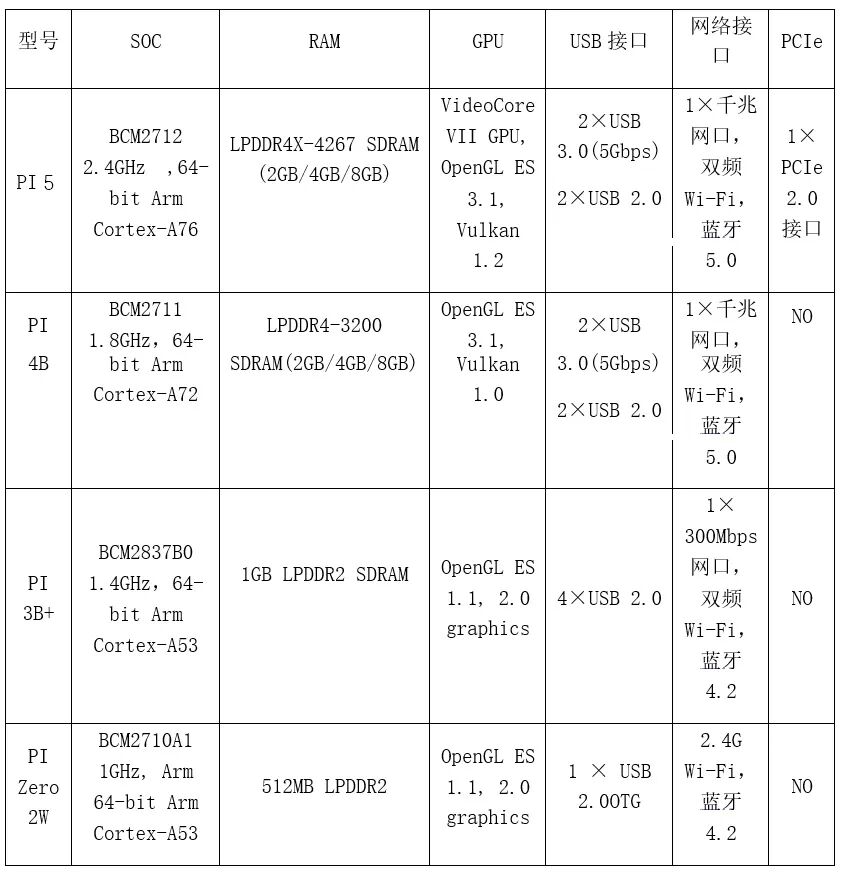
To watch the video, please visit the DigiKey Bilibili:
Five evaluations kick off the Raspberry Pi “Battle Royale”. Can the “champion” Raspberry Pi 5 hold its ground?

Evaluation Item 1: CPU Benchmark
For a board, the most concerning aspect is CPU performance. Whether for daily office tasks or AI applications, a high-performance CPU can provide a smoother user experience. We can find the CPU parameters for each PI in the official manual. So how do we evaluate CPU performance? The simplest method is to use benchmarking software for testing.
Here, we chose SysBench, an open-source, modular, cross-platform multi-threaded performance testing tool that can be used to test the performance of CPU, memory, disk, and other hardware. Before the formal test, we need to install the operating system on the Raspberry Pi. The system we used for this evaluation is Debian Bookworm Raspberry Pi Desktop (2024-11-19). The installation is very straightforward, so we won’t elaborate on that here. We powered on the four Raspberry Pis in sequence and logged in remotely using MobaXterm. We used SysBench version 1.0.20 to test the single-threaded and multi-threaded performance of these four Raspberry Pis. The test commands used are as follows:
sysbench cpu --threads=1 --cpu-max-prime=200000 runsysbench cpu --threads=4 --cpu-max-prime=200000 runAlright, the results for single-threaded and multi-threaded performance of the four Raspberry Pis are out. From the charts, we can clearly see the CPU performance differences among the various PIs, with PI5 being the standout.
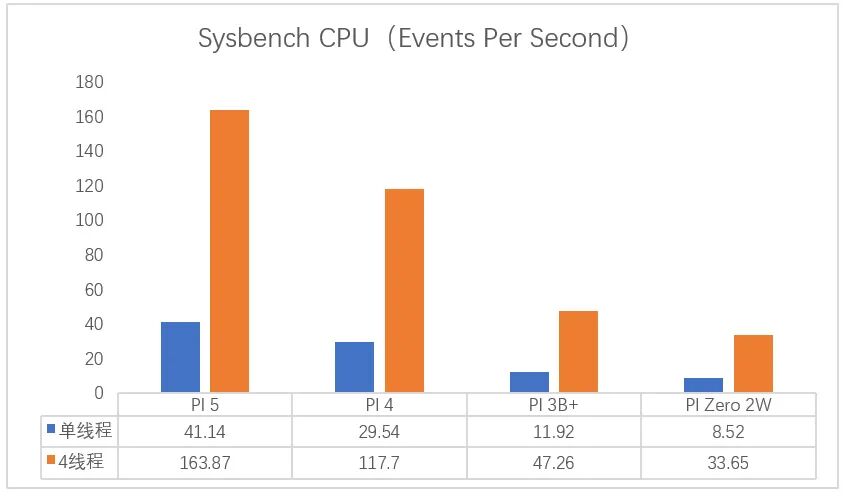
According to the official description, the performance of PI 5 should be 2 to 3 times that of PI 4, but based on the SysBench benchmark results, it is only 1.3 to 1.4 times. Is there a discrepancy? I don’t believe it and decided to use Geekbench for a comprehensive CPU performance test.
Unfortunately, PI Zero 2W and PI 3B+ have small memory, so Geekbench cannot run on them. Therefore, we only obtained reports for PI 5 (https://browser.geekbench.com/v5/cpu/23157434) and PI 4 (https://browser.geekbench.com/v5/cpu/23157440). From the Geekbench test results, the performance of PI 5 is about 2.3 times that of PI 4, which indeed meets expectations. Since SysBench and Geekbench use different testing benchmarks, the test data is for reference only.
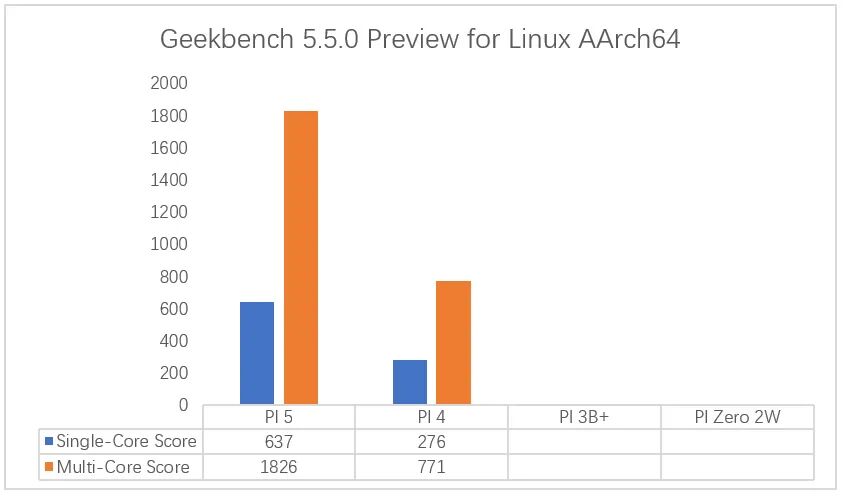

Evaluation Item 2: Memory Benchmark
Next, we will test the memory using SysBench, testing the read and write performance of the memory on these four Raspberry Pis with the following test commands:
sysbench memory --threads=4 --memory-block-size=1K --memory-total-size=2G --memory-oper=read runsysbench memory --threads=4 --memory-block-size=1K --memory-total-size=2G --memory-oper=write runThrough testing, we obtained the read and write results, with Raspberry Pi 5 still leading the pack. The higher the memory performance, the faster the data transfer speed.
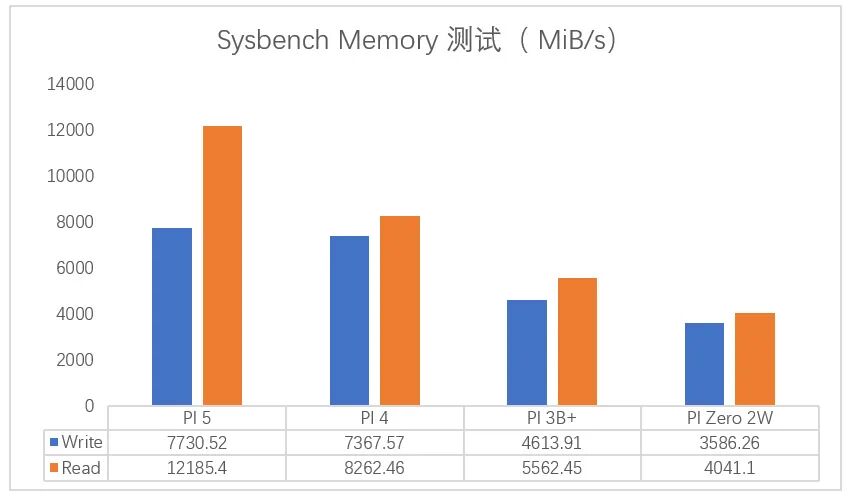

Evaluation Item 3: Network Test
For those who like to use Raspberry Pi for NAS or OpenWRT, network performance is extremely important, especially in NAS applications where the experience between 100Mbps and 1Gbps is vastly different.
PI5 and PI4 have Gigabit Ethernet ports, while PI 3B+ supports a maximum of 300Mbps. Testing was conducted using the best network hardware available on each board. The Zero 2W only has 2.4G WiFi, so we could only test it with its single network hardware. The WiFi on the other boards was not tested separately, and the testing was done using an MT6000 router. The testing software used was iperf3, with a Windows PC as the server and the Raspberry Pi as the client connecting to the server. The testing process was very simple.
Here are the test data we obtained. From the data, it can be seen that the internal network speed test results for PI4 and PI5 are not significantly different, making them suitable for use as NAS or soft routers. PI3B+ can be used as a smart home gateway, while Zero 2W, with only 2.4G WiFi, is only suitable as a micro gateway or terminal.
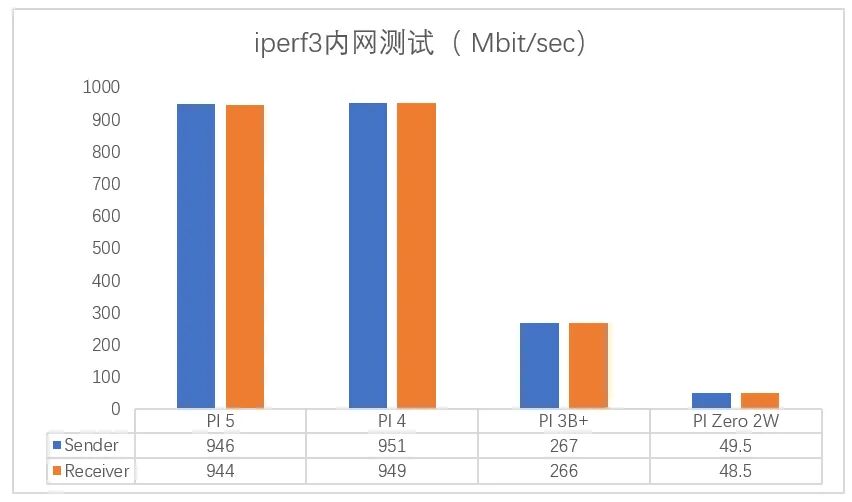

Evaluation Item 4: NGINX Performance
When using Raspberry Pi to set up personal websites or as a local server, the most commonly used component is NGINX. NGINX is an open-source high-performance HTTP and reverse proxy server. We have configured NGINX on these Raspberry Pis, and the testing tool used is wrk, a lightweight yet powerful HTTP benchmarking tool primarily used for performance testing of HTTP services in multi-core CPU environments. The following is the test command used.
wrk -t 4 -d 30s -c 100 http://127.0.0.1:80Here are the data obtained from the test. The benchmark data for PI 5 is very strong, making it completely capable of running small to medium websites.
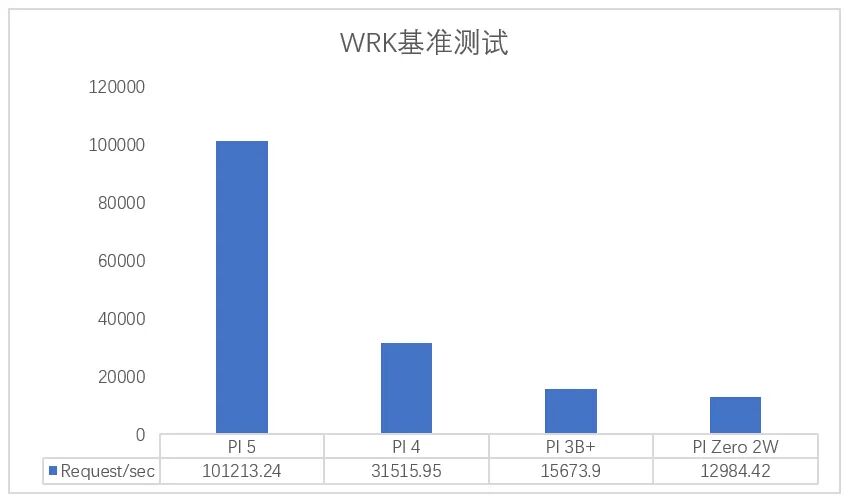

Evaluation Item 5: TF Card Read/Write Speed
When using Raspberry Pi, sometimes you may feel that operations are sluggish. Checking resource usage shows that CPU usage is not high. So what is the reason? This is actually caused by the slow read/write speed of the TF card used to install the system. The read/write speeds of TF cards differ among various PIs, even if you are using high-speed TF cards. Next, we will test the read/write speeds of TF cards. All four Raspberry Pis are using 32GB/Class10 TF cards, with the official maximum read speed of 100MB/s and write speed of 45MB/s. The testing tool used is Flexible I/O Tester, and we will conduct four sets of read/write tests with the following commands:
fio --loops=5 --size=500m --filename=fiotest.tmp --stonewall --ioengine=libaio --direct=1 \
--name=SeqRead --bs=1m --rw=read \
--name=SeqWrite --bs=1m --rw=write \
--name=512Kread --bs=512k --rw=randread \
--name=512Kwrite --bs=512k --rw=randwrite \
--name=4KQD32read --bs=4k --iodepth=32 --rw=randread \
--name=4KQD32write --bs=4k --iodepth=32 --rw=randwrite \
--name=4Kread --bs=4k --rw=randread \
--name=4Kwrite --bs=4k --rw=randwriteThe testing process is relatively long because the speed of the TF card is indeed slow. Here are the results we obtained. From the charts, it can be seen that the read/write speed of PI 5 has nearly reached the maximum speed of the TF card, while the data for the other boards is average.
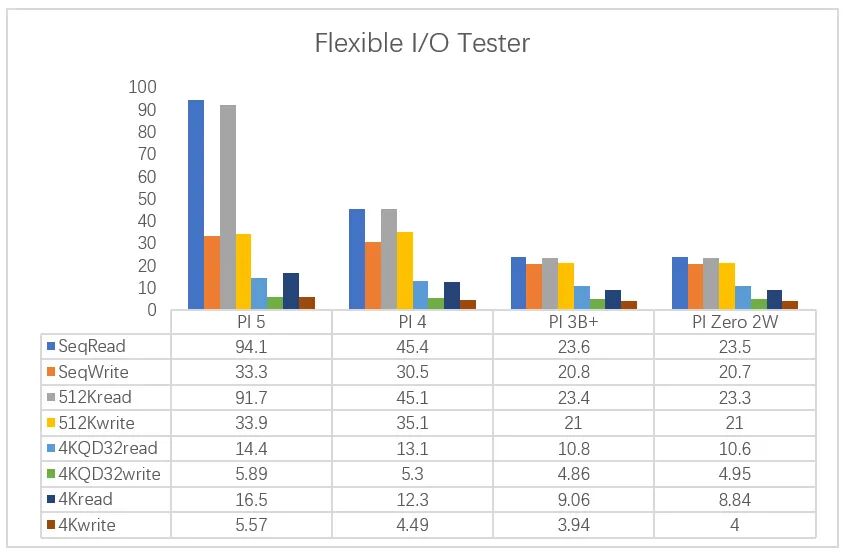
Although PI 5 has a fast read/write speed for TF cards, there is still a speed bottleneck. For a better user experience, one can consider the unique peripheral of PI 5—PCIe. We can use a PCIe to NVME SSD adapter board to install an SSD and then install the system on the SSD. Here we have installed a 500GB NVME SSD on PI 5, and upon entering the system, we can see that the system is booting from the SSD. Next, we run the Flexible I/O Tester again, and this time the test is very fast. We compare the data for booting from SSD versus TF card. The read/write speed using SSD is over 10 times faster than using TF card, and even when using the desktop environment, operations are very smooth.
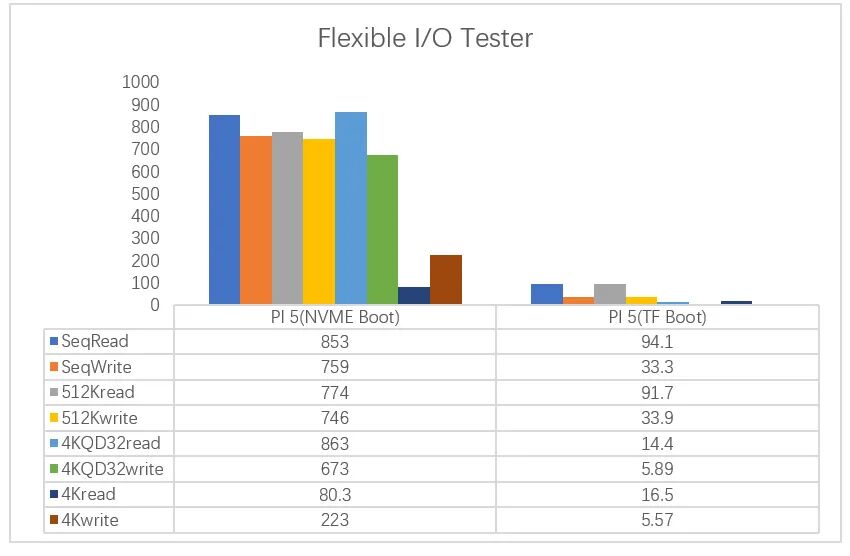
PI 5’s PCIe interface can not only connect to SSDs but can also be used to expand to a 2.5G Ethernet port, which is great news for NAS enthusiasts. We installed a PCIe to dual 2.5G Ethernet port expansion board and ran the internal network speed test again using iperf. Here are the data obtained from using the PCIe to dual 2.5G Ethernet port compared to the built-in Gigabit Ethernet port of PI 5. The speed of the 2.5G port is 1.5 times that of the Gigabit port, making it very suitable for NAS use. Of course, using the 2.5G expansion requires that other devices in the local area network also support it.
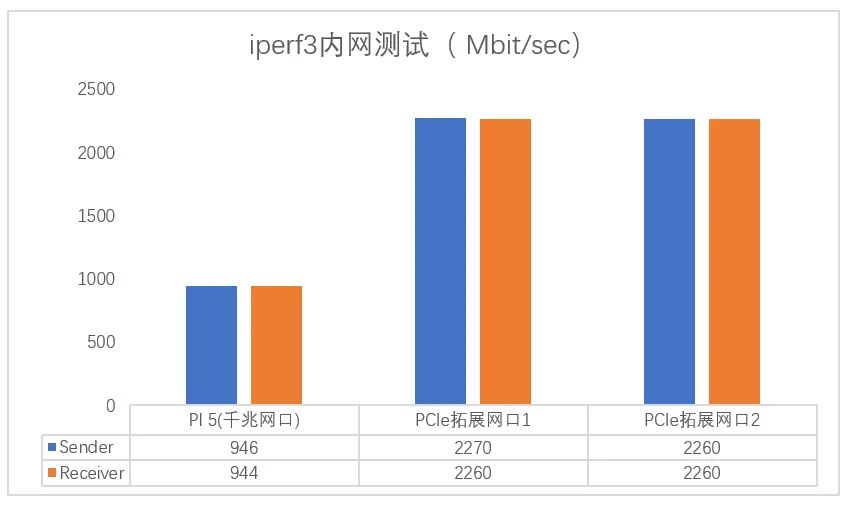
Through these five tests, it is clear that each upgrade of the Raspberry Pi represents a performance breakthrough, especially in the performance experience of the Raspberry Pi 5. The Raspberry Pi board ecosystem is very robust; I have not seen any other open-source board from any other company that allows different boards to run the same system and adapt the system accordingly, including providing system support for older boards like Zero, PI 2, and PI 3 that have been released for many years. This is a remarkable achievement.
This concludes our evaluation. See you next time.
Links used:
SC1166
SC0329
SC1111
SC0073
SC0193(9)
SC1176

Editor’s Note:
Through this practical test, we can see that the performance of the Raspberry Pi 5 has indeed improved significantly. For developers, the Raspberry Pi 5 offers extensive hardware compatibility, powerful development capabilities, flexible networking solutions, efficient storage and expansion options, as well as rich community support and resources, providing a strong development platform for makers and developers. Are you already using the Raspberry Pi 5 for development? What insights or questions do you have regarding applications? Feel free to leave a comment and share your thoughts!
